|
|
|||
THIS WEEK at HILTON POND
8-14 October 2006
Installment #332---Visitor #
(Back to Preceding Week; on to Next Week)
|
WHEN IT'S DREARY AND COLD |
|
COMMON GRAPE FERN:
SAFE HAVEN ON A TIP-UP MOUND Since what is now Hilton Pond Center was used for row crops or grazing for aabout hundred years, natural vegetation--especially wildflowers--was pretty much eliminated. Additionally, the lack of a tree canopy made it difficult for shade- and moisture-loving plants to survive, so it's not surprising ferns are few and far between at the Center--especially when they also have to compete with alien ground cover such as Japanese Honeysuckle, Stilt Grass, and Vinca that invaded the property. Tip-up mounds form when big trees fall over and pull up surrounding soil with their roots. The mound in question (left) was created 'way back in 1988 when Hurricane Hugo blew over a towering Eastern Red Cedar that fortunately fell away from the farmhouse. Cedar is rot-resistant, so both the tree and its root network, although dead, remain nearly intact after 18 years. And the big tip-up mound--made of hard-packed red clay that's only slightly eroded--still juts above the surrounding landscape, providing a place where new vegetation has a chance without competing with established plants at ground level. Currently the mound supports seedlings of Southern Magnolia, Eastern Redbud, Groundsel-bush, Bear Oak, and a few other species, and--in the shade of a young Shagbark Hickory--there grows a healthy foot-high fern, complete with fruiting bodies.
All text & photos © Hilton Pond Center Apparently thriving near the base of the tip-up mound is one of the Grape Ferns, so-called because its taller fertile frond contains hundreds of spherical sporangia that resemble bunches of grapes on a vine. The non-reproductive part of the fern is a green sterile frond that branches into three petioles bearing triangular leaflets (above and below); these branch into subleaflets that, in turn, are further dissected into many thumb-like lobes along a central vein.
All text & photos © Hilton Pond Center Because the edges of subleaflets of our new fern are only a little jagged (below), we believe it to be Common Grape Fern, Botrychium dissectum, rather than a closely related Rattlesnake Fern (AKA Virginia Grape Fern), B. virginianum; the latter also occurs at Hilton Pond Center but has heavily serrated subleaflets and fruits earlier in the year. That said, botanists apparently disagree over the taxonomy of various Botrychium species in the Carolinas, mostly because the degree of leaf serration--long-used to separate one fern from another--is highly variable even within a given species. It's apparent DNA studies need to be relied upon if science is to understand the true genetic relationships among and between members of the genus; for now we're sticking with B. dissectum for the fern pictured herein, but we welcome evidence to the contrary. (One confirming characteristic might show up later, since leaves of B. dissectum are reported to turn bronzy-green in winter.)
All text & photos © Hilton Pond Center As a group, ferns are considered to be "primitive plants," i.e., they carry out photosynthesis but bear no flowers. Around since the Carboniferous Era, some fern species have been so successful they are almost unchanged after 360 million years. Unlike other ancient, primitive flora such as mosses and liverworts, ferns are vascular plants; i.e., they have conductive tissues that transport water (via xylem) and food (via phloem) to and from roots and leaves. This allows some types to grow well above the substrate--even as tall as 50 feet in tropical Tree Ferns. Across temperate North America ferns are considerably smaller, seldom growing taller than three feet or so.
All text & photos © Hilton Pond Center One interesting aspect of ferns is the way they reproduce. All ferns produce spores--sometimes in capsules like those on our Common Grape Fern (above left), but also in sori--little brown dots of the undersides of leaflets. We were impressed by the number of globe-shaped sporangia produced on the Common Grape Fern's fertile frond, so we took a series of photos of increasing magnification. As we zoomed in with our variable macro lens, we discovered the general shape of the fertile frond mimics that of the sterile leafy one, but that its subleaflets are narrow and pointed (above right). Attached to each subleaflet are two rows of greenish-white sporangia, and each little sphere has what appears to be a groove across its equator. It's worth noting that each sporangium is only about one millimeter in diameter.
All text & photos © Hilton Pond Center In order to get an extremely close view of these reproductive structures, we snipped a fertile subleaflet and brought it into the lab, where we clipped it to a stand in front of our camera lens. (It was quite breezy outside, and even a little wind would have made it impossible to take a photograph with our most powerful macro lens.) At five-to-one magnification (above), the fern's sporangial spheres took on a whole new appearance, looking like little melons with lightly pitted surfaces and each with an even more-noticeable horizontal seam. Also of interest were little flecks of red mud that tagged along with the fertile frond as it sprouted from the clay of the tip-up mound. After shooting several exposures at various apertures, we finally got the photo above and left the whole set-up in place as we retired for the night.
All text & photos © Hilton Pond Center Next morning we arose early and ambled toward the desk where we had taken our photos the night before. Looking through the camera's viewfinder we were delighted to see several sporangia had burst along their seams, revealing hundreds--perhaps thousands--of translucent white spores within each. Some of the dry spores adhered to the outsides of spore capsules--which must have been at least a little sticky--but others rained onto our desk surface and covered it with a very thin film. Additional capsules burst during the day, and by the following day nearly all had popped. We placed the open capsules and what must have been a jillion spores on a piece of wet filter paper in a petri dish hoping they would germinate, but nothing happened within 48 hours. Under more natural conditions, the spores would be transported by wind or flowing rainwater to an appropriate substrate, where with proper stimuli and nutrients a successful spore would sprout to produce a "prothallus." As days pass, we keep looking into the petri dish with the fern spores, hoping to find a little green prothallus developing, but it may never happen. It's hard to duplicate natural conditions that stimulate a spore to germinate, and we almost certainly need to add some nutrients to our culture. As an alternative we'll just be alert next spring for a tiny prothallus or two from the Common Grape Fern, growing in safe haven on our Hilton Pond tip-up mound. All text & photos © Hilton Pond Center
Comments or questions about this week's installment?
Thanks to the following fine folks for recent gifts in support of Hilton Pond Center for Piedmont Natural History and/or Operation RubyThroat: The Hummingbird Project. Your contributions allow us to continue writing, photographing, and sharing "This Week at Hilton Pond." (See Support if you'd like to make a gift of your own.)
"This Week at Hilton Pond" is written & photographed You may wish to consult our Index of all nature topics covered since February 2000. You can also use our on-line Hilton Pond Search Engine at the bottom of this page. For a free, non-fattening, on-line subscription to |

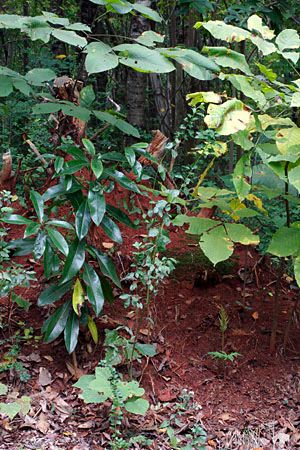 To date we've found only
To date we've found only 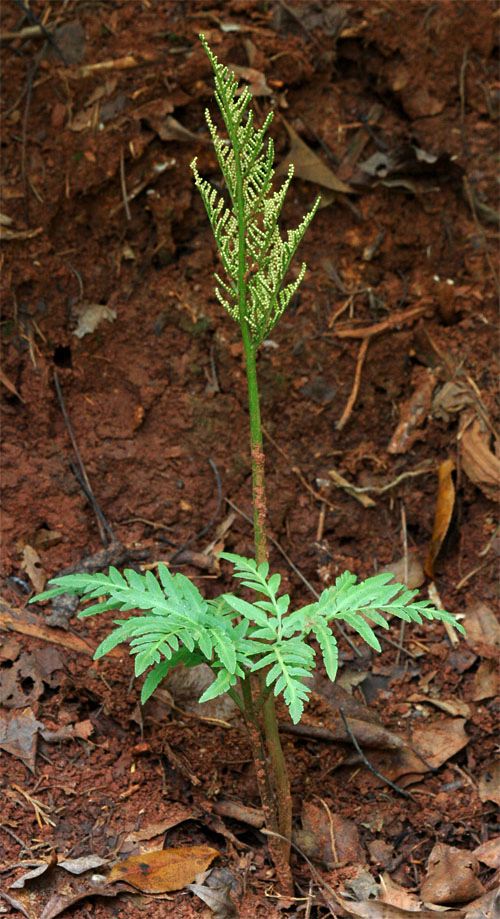
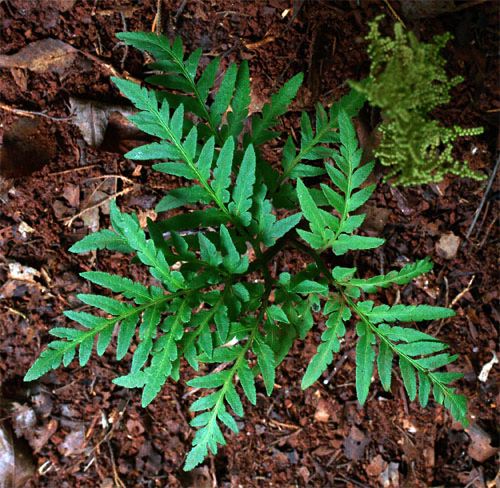
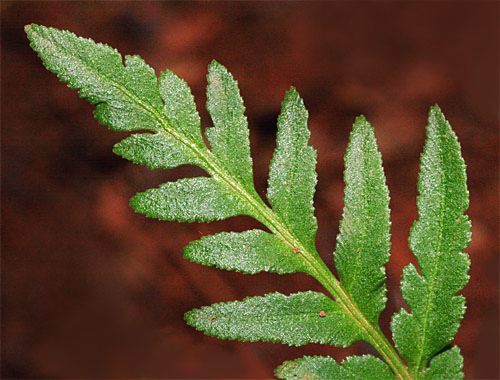
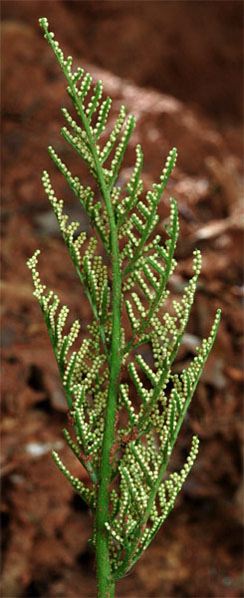 .
. 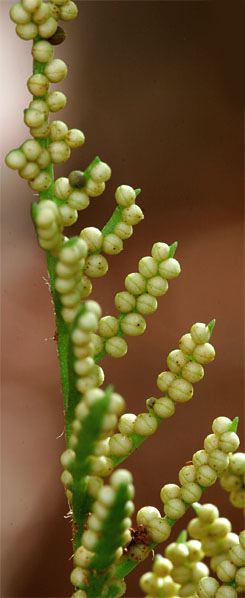
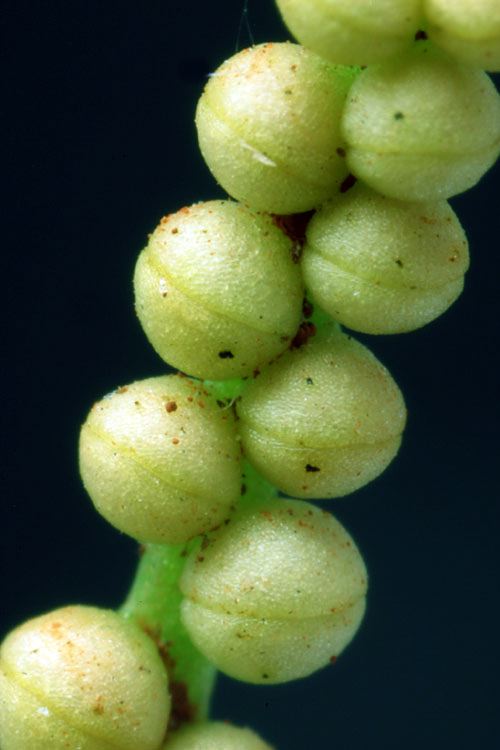
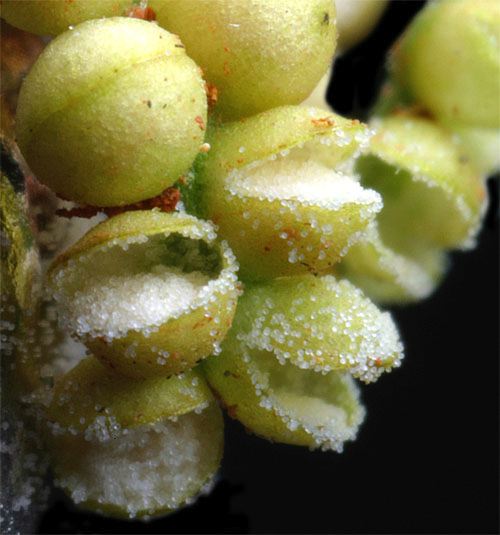
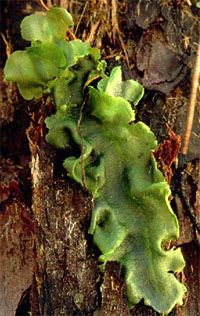 This structure--which grows to eventually resemble a little piece of bright green lettuce (below right)--gives rise to haploid male and female gametes (egg and sperm) that fuse to produce a diploid embryo with paired chromosomes. Over time, the embryonic fern grows from the prothallus to become an adult that eventually produces a new sporangium. Because the fern has these two very different parts to its life cycle--the relatively small prothallus and the more-familiar macroscopic frond--ferns are said to go through "alternation of generations." If this all seems a little complicated, just remember the big fern plant is the sporophyte ("spore-bearing") generation, while the small prothallus is the gametophyte ("sex cell-bearing") generation.
This structure--which grows to eventually resemble a little piece of bright green lettuce (below right)--gives rise to haploid male and female gametes (egg and sperm) that fuse to produce a diploid embryo with paired chromosomes. Over time, the embryonic fern grows from the prothallus to become an adult that eventually produces a new sporangium. Because the fern has these two very different parts to its life cycle--the relatively small prothallus and the more-familiar macroscopic frond--ferns are said to go through "alternation of generations." If this all seems a little complicated, just remember the big fern plant is the sporophyte ("spore-bearing") generation, while the small prothallus is the gametophyte ("sex cell-bearing") generation.

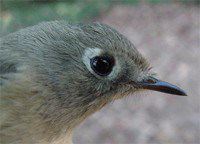
 Please report your
Please report your Oct 15 to Mar 15
Oct 15 to Mar 15
